Results of the 2022/23 Rule Update Vote
TL;DR (the quick version):
- All proposed rule changes passed. We ONLY counted votes if a club representative responded to the survey ballot. If a club did not respond, we did NOT include it in the vote totals.
- We will incorporate suggested changes from the “Yes, with change” votes when actionable. You can read more in the details for each rule regarding how we determined this and which changes will be incorporated.
- The closest vote on a proposed rule change was Mallet Hooking & Interference. While this rule change passed, we plan to vote again on Mallet Hooking & Interference next season. Players will have time to try it out and give us feedback or perhaps adapt in the same way they did with Interference/Obstruction and change their opinion. Consider this season a pilot for the new rule.
- The updated ruleset is available here, pending another update for problematic behavior: https://nahbpa.gitbook.io/2022/
Resultados de la votación de los cambios al Reglamento 2022/23
- Todos los cambios propuestos han sido aprobados. Sólo contamos los votos que un representante de clúb emitió al llenar el formulario de votación. Si un club no respondió, no les incluímos en el total de votos.
- Incorporamos los cambios sugeridos en aquellos votos “Sí, con cambios” cuando sea posible. Puedes leer más en los detalles de cada regla acerca de cómo hemos determinado esto y qué cámbios sugeridos serán incorporados.
- La votación más cerrada fue la del cambio propuesto a la regla de Enganchadas de bastón/mallet e interferencia. Mientras esta regla ha sido aprobada, tenemos planeado someterla a votación de nuevo la siguiente temporada. Lxs jugadores tendrán tiempo de probar la regla y emitir retroalimentación o tal vez adaptar la regla en la misma forma en la que se hizo la regla de interferencia/Obstrucción y cambiar su opinión. Considera ésta temporada como prueba piloto de esas reglas.
- El conjunto de reglas actualizado esta disponible aqui, pendiendo otra actualizacion para conducta problematica: https://nahbpa.gitbook.io/2022/
First and foremost, we want to thank all of the clubs for being actively engaged in this process. We realize that the ruleset is a technical document to read and parse, and on top of that it only gets used in its entirety at 1 or 2 tournaments each year for most people. The ongoing evolution of the game is primarily done within your clubs and at all of the amazing tournaments you stage throughout the year, but we have to attempt to codify standards so that at a competitive level there is safety, fairness, fun, and excitement.
Before we go into the details of the voting results, we wanted to share what’s come to light from the many conversations we’ve had during this process. The future of refereeing and ruleset management is a constant topic of discussion. To that end, here is a short list of projects and process changes that you can expect to see in the coming years:
- Rules
- NAH will develop a mechanism for an even more democratic system of rule change proposals and edits for clarity. There is a perception that the ruleset is the product of an opinion of one person or small group of people, and we are committed to changing that perception.
- NAH will develop a shorter, simpler “Players Handbook” intended to help newer players and players who are not interested in Refereeing to understand the standards established in the current ruleset. This is often done in other sports leagues. The current ruleset is intended to be a technical document for Referees and tournament organizers to comprehend thoroughly. Having a Players Handbook written in a more plain language, with examples and videos, would help tremendously with the accessibility of the rules.
- Refereeing
- NAH will work with other groups and individuals to dedicate resources to training more Referees and increasing overall fluency of the ruleset within the community. Players may remember that in 2013/14 we had developed a Referee certification test that included videos, but it required manual grading and was much less interactive than any in-person training would be. Additionally, the overhead required to maintain, update and process those tests was not sustainable given that only a handful of folks were interested in it. To that end, we realize that something else needs to be done and we believe events that focus on Refereeing will be more engaging and a better use of resources.
If you’d like to get involved in any of these efforts, you are always welcome to join the team!
Voting Results
Overview and how to read the results:
- First, if a club did not respond or vote, we did NOT include it in the vote totals. The only votes that were counted were if a club representative responded to the survey ballot.
- The graphs below represent the votes as cast by club representatives. We also address any of the “Yes, with changes” and how we plan to incorporate the requested changes into the ruleset.
- We paraphrased the feedback received, so as not to attribute the concern or suggestion to one particular club.
- At the end of the feedback discussion for each proposed rule, we include the “adjusted vote count” bolded and highlighted. For each change we could incorporate (“Yes with changes” = “Yes”) and changes we could not incorporate (“Yes with changes” = “No”), we adjusted the overall vote counts so you can see the final vote count after addressing the feedback and requested changes.
Flagrance
The flagrance rule update has passed.
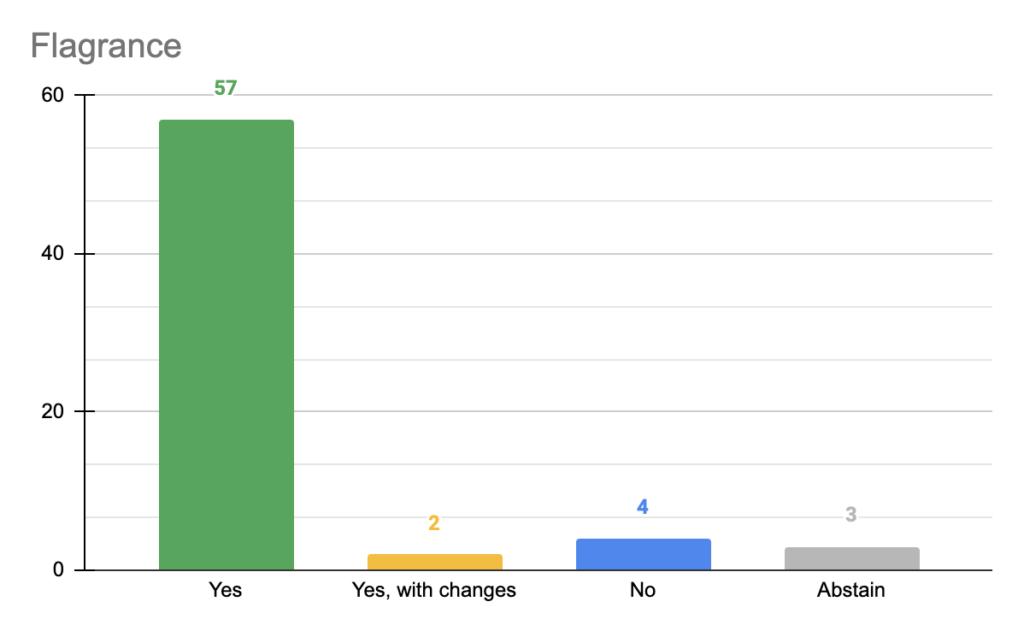
This update will hopefully hold every player on the court to a standard of play where physical contact is executed safely and strategically. There were no changes proposed that were actionable, so those votes were counted as “No.” The final adjusted count remains the same as cast: 57 Yes, 6 No, 3 Abstain.
Escalation & Accumulation
The escalation & accumulation rule update has passed.
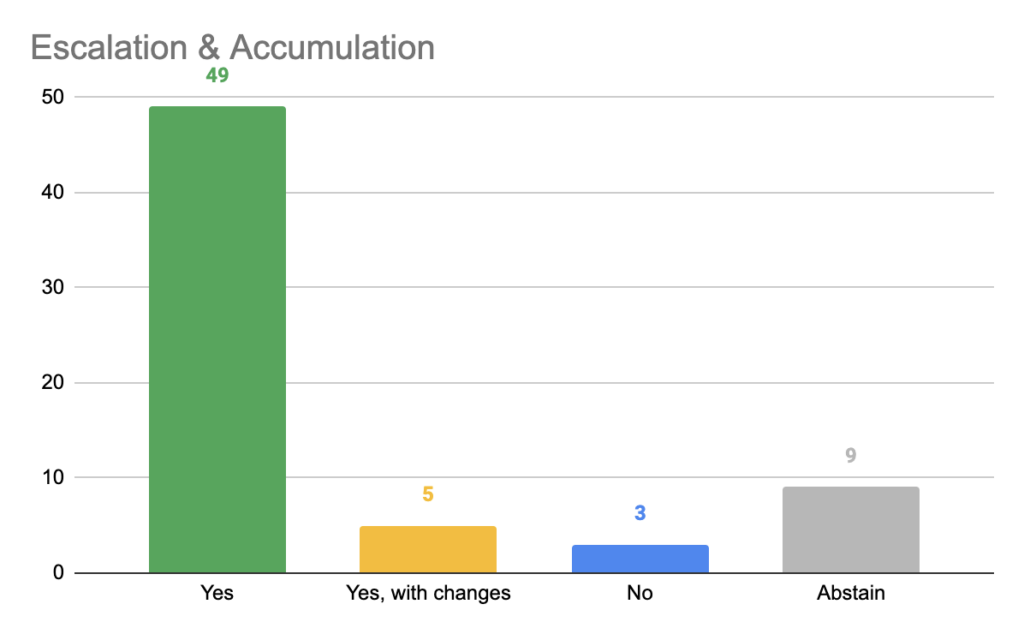
There were two suggested changes that are actionable:
- We should remove the requirement for dabbing for escalation to a minor.
- We should create a template to use for tournaments to track player fouls
Our response to the first suggestion, is that 6.1.2.1 does state that a Referee does not have to assess a ball turnover and may assess a Minor or Major regardless of if the player dabbed, based on a number of factors at the Referees discretion. If we removed language from 6.1.2.1 or 6.1.2.2 it would remove ball turnovers from the game entirely, which we fully support, however, it would potentially change how other clubs voted. We will not be incorporating that change. This suggestion didn’t feel like enough to change the vote from a ‘Yes’ to a ‘No’.
In regards to the second suggestion, we can absolutely provide a template for qualifiers or any other tournament so the Scorekeeper can track goals and infractions. We counted this suggestion as a ‘Yes’ vote.
An updated version of the proposed rule will be released in the final version of the ruleset.
Of the “Yes, with changes” votes, there were 3 that were either actionable or already included in the rule, and 2 that we cannot incorporate into the rule without it significantly impacting the other votes, so we are counting those as “No” votes. The final adjusted vote count after incorporating changes or “rejecting” changes is 52 Yes, 5 No, 9 Abstain.
Problematic Behavior
The problematic behavior rule addition has passed.
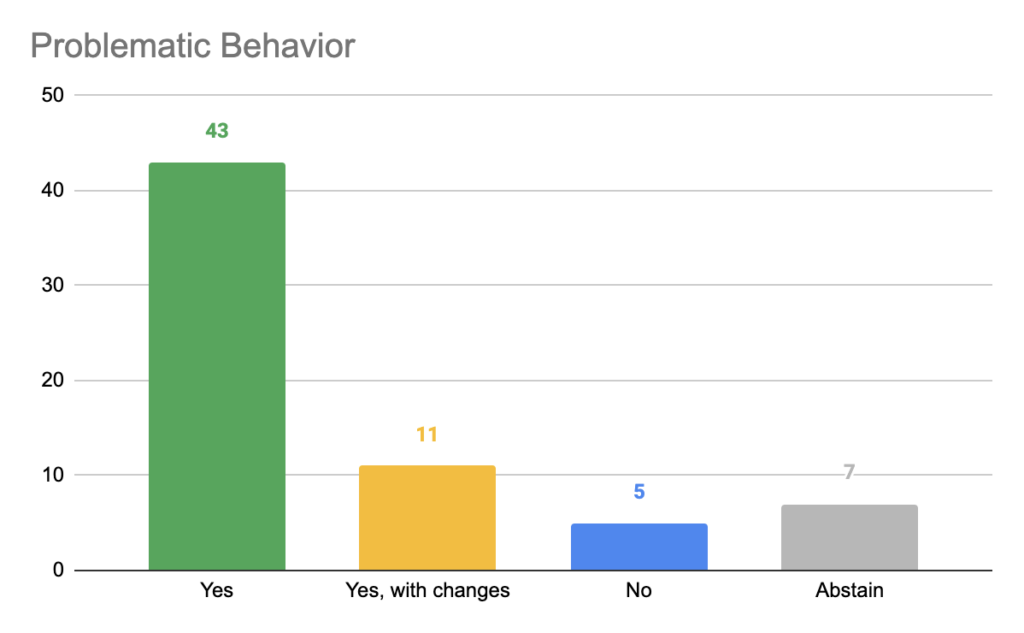
There were many suggestions and concerns in regards to this rule. Here are a few paraphrased points that were made, and some actionable suggestions:
- It should only be tournament organizers who determine if a player is eligible, not team captains.
- This rule should only be invoked PRIOR to the tournament, with a reasonable amount of time for that team to find a replacement and to prevent someone from booking travel to a tournament they are not eligible to play in.
- The player raising concerns should not have to reveal any personal information during this process.
- The problematic player should have a chance to defend themselves.
- There should be ongoing conversation about this rule and how to improve it.
- NAH should provide a standard form to be filled out, to ensure this process doesn’t create more problems.
- There are general concerns about people weaponizing this rule for malicious or petty reasons.
This is all great feedback and input. NAH will work to provide a more formal process (along with producing the Code of Conduct in question) which will include a template that will standardize the process and help to protect the individual(s) who are invoking the rule from any further harm. The way the rule is written, there was no expectation that the player invoking the rule would have to reveal more personal information than needed, and they can even have someone else raise the concern on their behalf to remain anonymous.
In regards to the tournament organizers or NAH having the sole responsibility of determining player eligibility, we would argue that is a step backwards. Often there is a majority of players competing in the tournament who feel uncomfortable with someone who is there, but the organizers cannot empathize and therefore will not act on the concern. This process is not intended to be a “trial of peers” but rather a platform for everyone in the tournament to have an equal voice where they may have had no voice at all in the past. We firmly believe that the NAH cannot act as a court and that tournament organizers are much too small of a group to bear this burden either. We will not be making that change to the rule at this time, however this is what we will do: NAH will help put together a working group to evolve this rule with additional voices in the room. It was a group effort for this first draft, and we hear you loud and clear that perhaps a second look is warranted. That is fair, and we will work to make this happen before qualifiers if possible, but it may take time to find common ground.
An updated version of the proposed rule will be published in the final release, but we are committed to reassessing it when the working group feels ready to make changes.
Of the “Yes, with changes” votes, there were 5 that were actionable, and 6 that were not actionable at this time or went beyond the scope of what can be done within the ruleset specifically. The final adjusted vote count after incorporating changes or “rejecting” changes is 48 Yes, 11 No, 7 Abstain.
Penalty Shots
The penalty shot rule addition has passed.
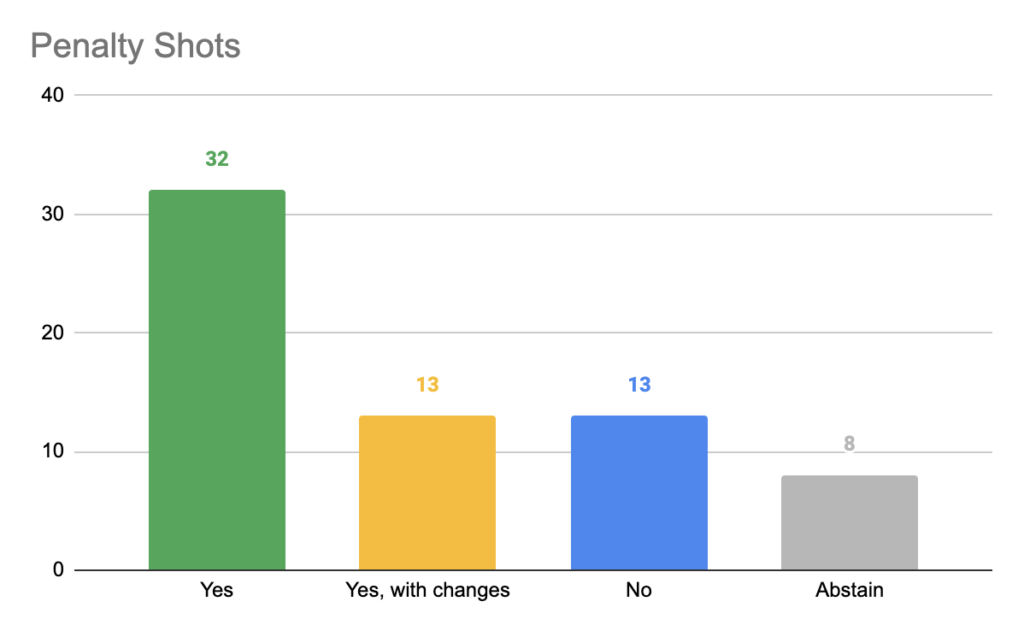
There were a few consistent suggestions/questions:
- Remove the possibility of the shooter having a second shot from a rebound.
- The player who was fouled should take the shot, and the player who was in net should have to be in net.
- Remove the penalty shot on an empty net and just award the goal.
- The goalie should have to remain in the crease until the penalty shot is taken.
These are all valid suggestions, and because of the volume of them, we will incorporate them into the rule. Additionally, the rule states that play is dead after the penalty shot occurs, and outlines exactly how play will restart. There was some confusion around whether play would begin immediately as if the ball is live after the penalty shot, but this seemed too unpredictable at this point in time. The updated version of the proposed rule will be published in the final release of the ruleset.
Of the “Yes, with changes” votes, all of them were actionable and their incorporation would likely not change the other Yes votes. The final adjusted vote count after incorporating changes is 45 Yes, 13 No, 8 Abstain.
Mallet Hooking & Interference
The mallet hooking & interference rule update has passed.
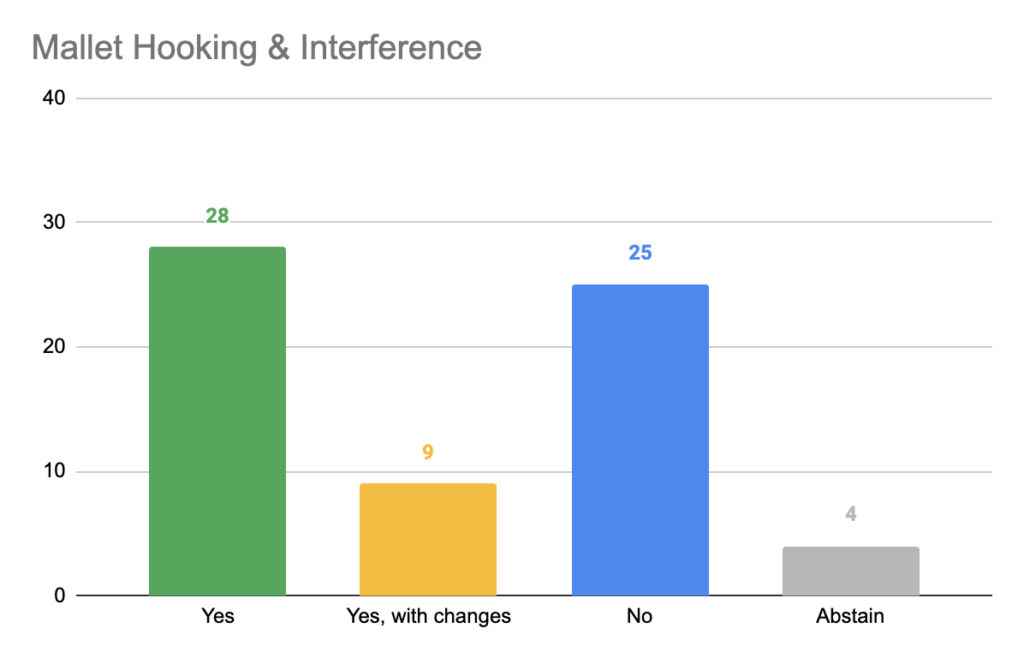
This was the most divisive of votes, and we received a lot of good feedback. We will do our best to paraphrase the common themes that were shared:
- More specificity is needed around when and where a player can play a mallet.
- Hooking should be allowed in certain scenarios but not others.
- This rule feels like a style being imposed and could result in biased Refereeing.
- The rule should focus on unsafe mallet play and not tactical mallet play.
The majority of feedback came from ‘No’ votes, but we will focus our responses on the feedback that came from ‘Yes, with changes’ votes:
- We believe that allowing hooking in some situations but not others will only add more confusion to this rule and that an outright hooking ban is much easier to communicate and enforce. Incidental hooking will happen the same way incidental bike contact happens, and that’s okay. The work now is to focus on applying the rule and getting Referees on the same page about how to enforce it.
- We acknowledge that in the first implementation of a rule like this that specificity helps significantly with the learning curve. Just like with Interference/Obstruction, there was confusion about where players could ride or not ride, be or not be. This is okay. NAH will update the rule to add more clarity before implementing it, and will work with the clubs who expressed this concern so that the final language is satisfactory.
- In the same way that Europe felt targeted by the Interference rule and Crease rule initially, we can understand why this might feel like a condemnation of a certain style of play. Conceptually, we never considered mallet play to be part of any specific style, and it appears clubs in all geographies voted ‘Yes’ and ‘No’, which demonstrates clearly that the regional narrative may be a bit too reductionist. However, we did want to highlight the concern that there may be Referees who have a certain point of view and may punish certain players. While this is a fairly non-specific argument to this rule — it could be applied to any rule, really — it is still a completely valid concern and hopefully through education, conversation and collaboration we can prevent that from happening. Every Referee has different thresholds for actions and expecting them to be mechanical or robotic is not possible at any level of sport. What is a handlebar infraction to one Referee may be incidental bike contact to another Referee. This is the reality of Refereeing. All we can do is give everyone a platform for raising their concerns and participating in future Referee training efforts, and encouraging conversation within the community.
- We believe that you cannot separate mallet safety from tactical mallet play, because it’s often tactical maneuvers that result in the dangerous situations. Additionally, we want to double down on the competitive reasoning behind the rule proposal: The premise is that restraining a player with anything other than your position on the court is antithetical to the spirit of the game. In our discussions and revisions of the rule, it became clearer that a play on the ball that involves restraining your opponents equipment certainly creates the unsafe situations and is arguably in opposition to free and open movement on the court. Some would argue that strategy, skill, and execution are the three core components of the game, and restraining a player’s mallet, arms, pulling jerseys, etc, neutralizes all three of those qualities. This rule proposal was a referendum on that premise and the results show that many folks who play at every level agree.
You may agree or disagree with the points made above and clearly the community is reasonably divided. Because of that reality, NAH is committed to voting on this rule again next season. Players will have time to try it out, find the boundaries of the rule, give us feedback and perhaps adapt in the same way they did with Interference/Obstruction. Consider this a pilot season for this rule, and hopefully next year we will be able to have individual players vote on this to get a better sense of how people feel about playing the game this way in a competitive environment.
Of the ‘Yes, with changes’ votes, we felt that 7 of them could be addressed and 2 of them could not. The final adjusted vote count after incorporating changes or “rejecting” changes is 35 Yes, 27 No, 4 Abstain.
The updated version of the proposed rule will be published in the final release of the ruleset.
Club Voting Records
Cascadia
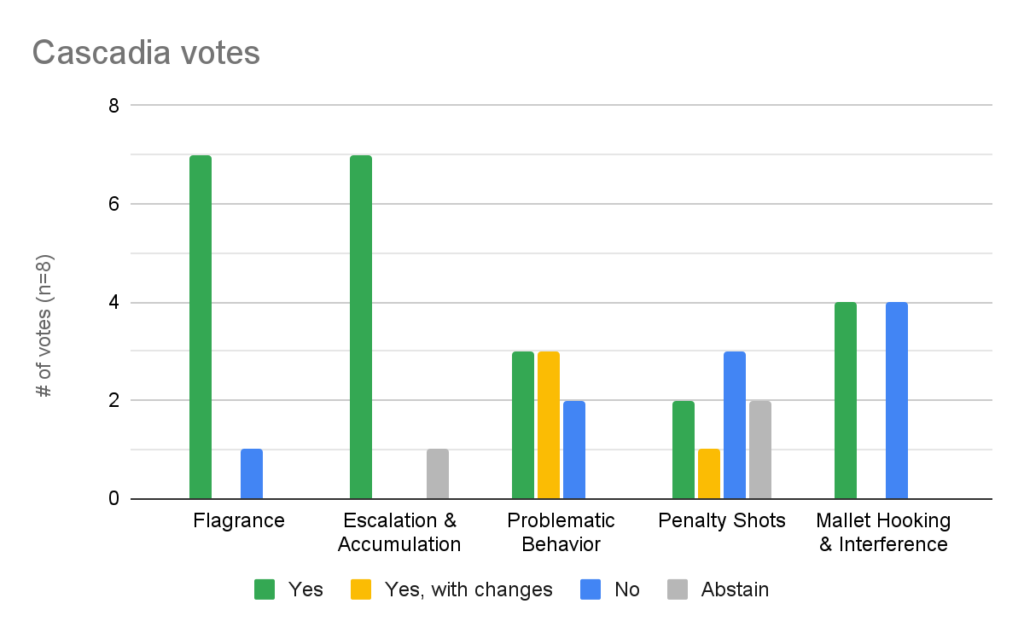
Eastside
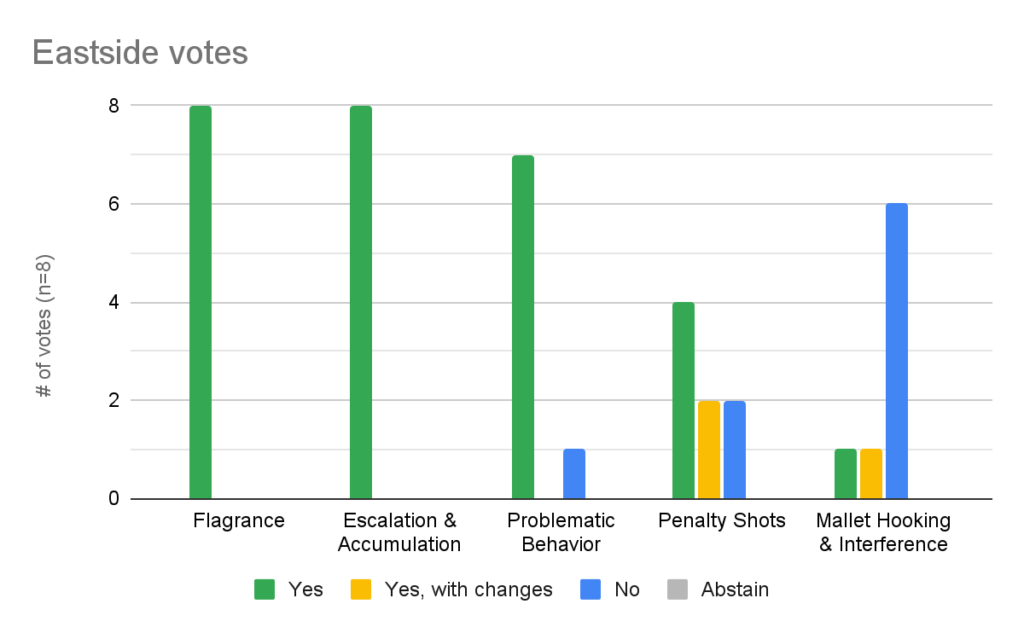
Great Lakes
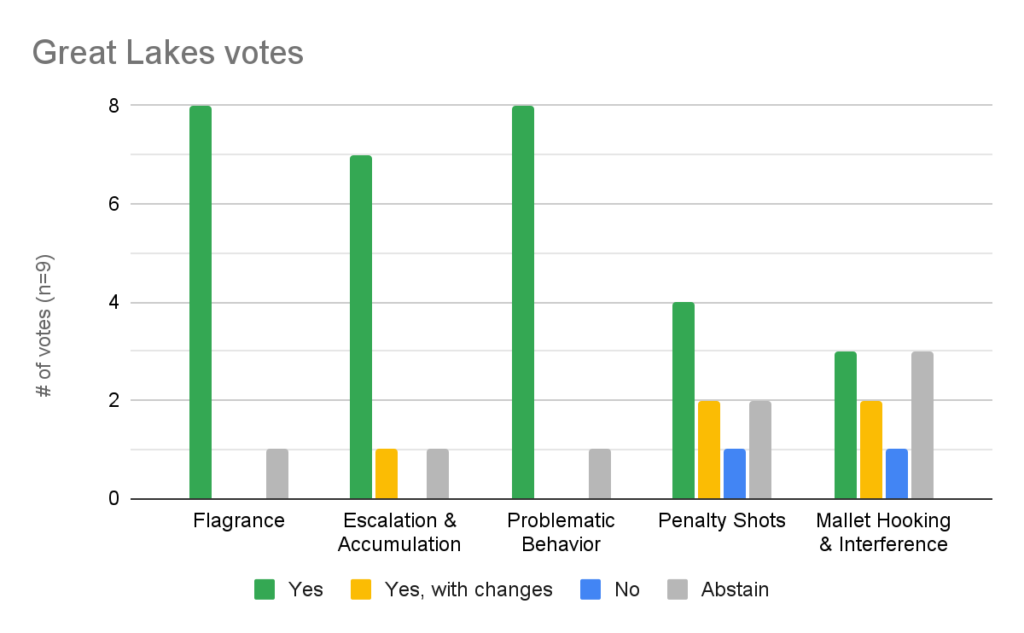
Great Plains
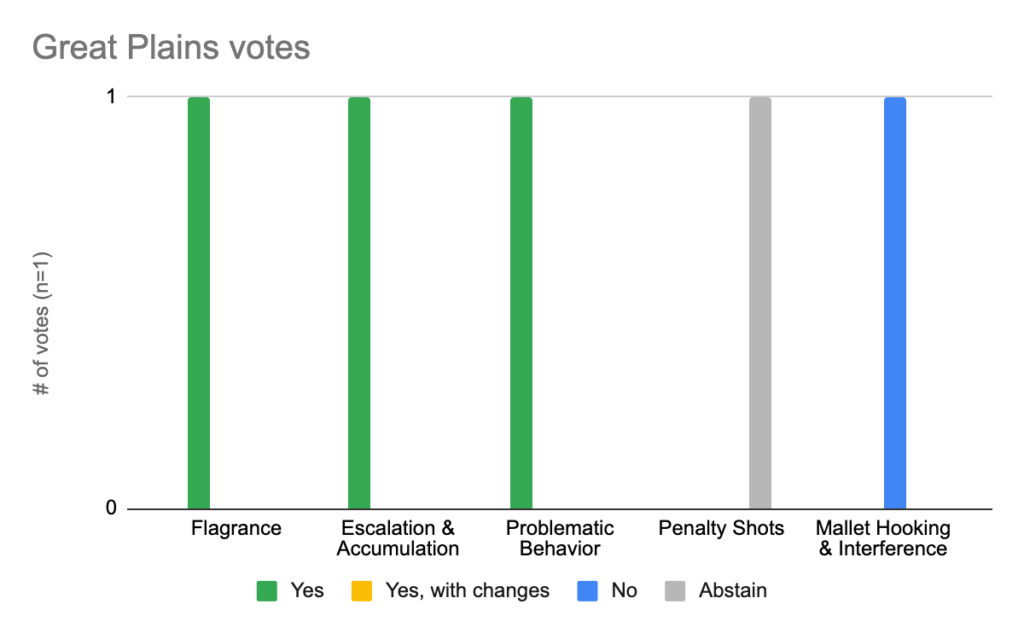
Heartland
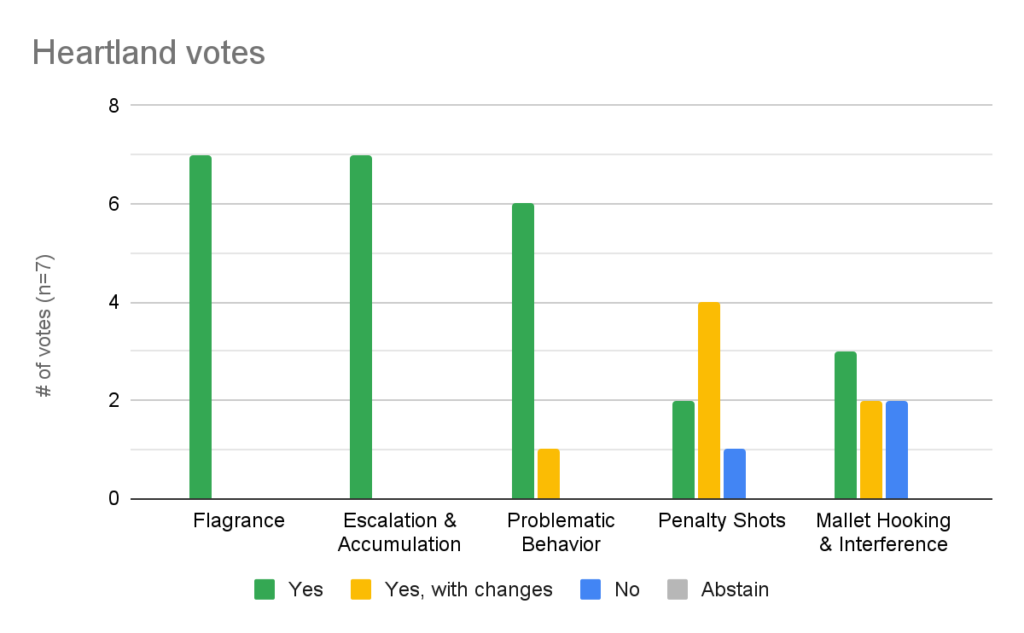
Mexico
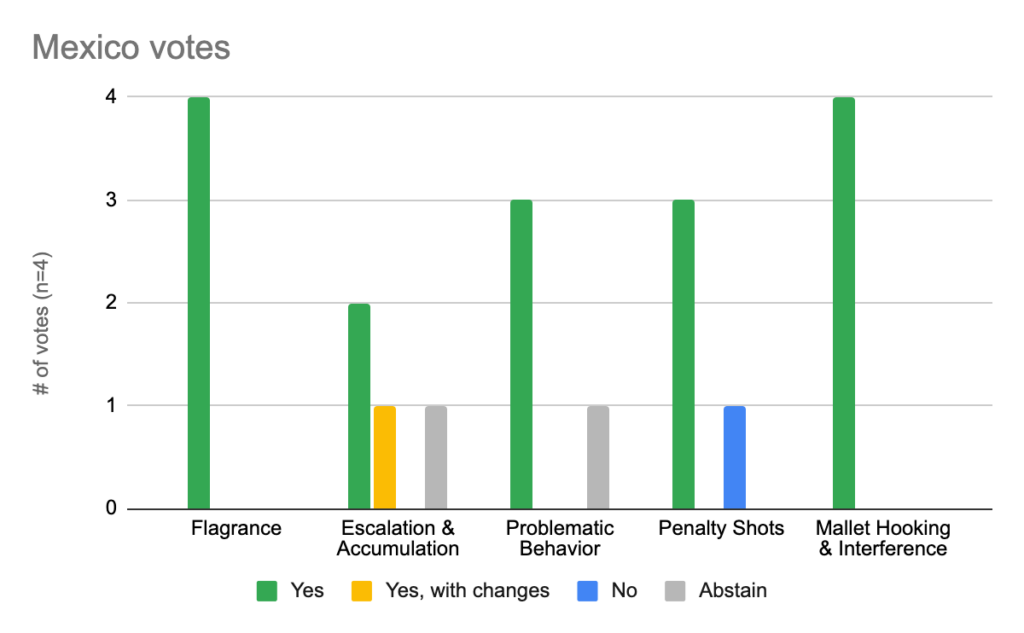
Northside
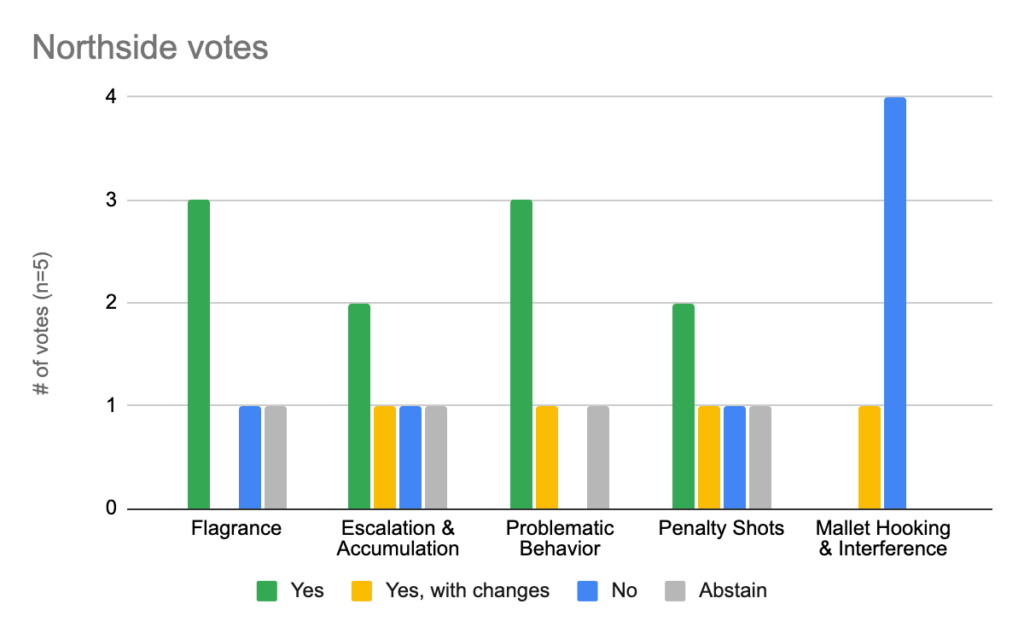
South Central
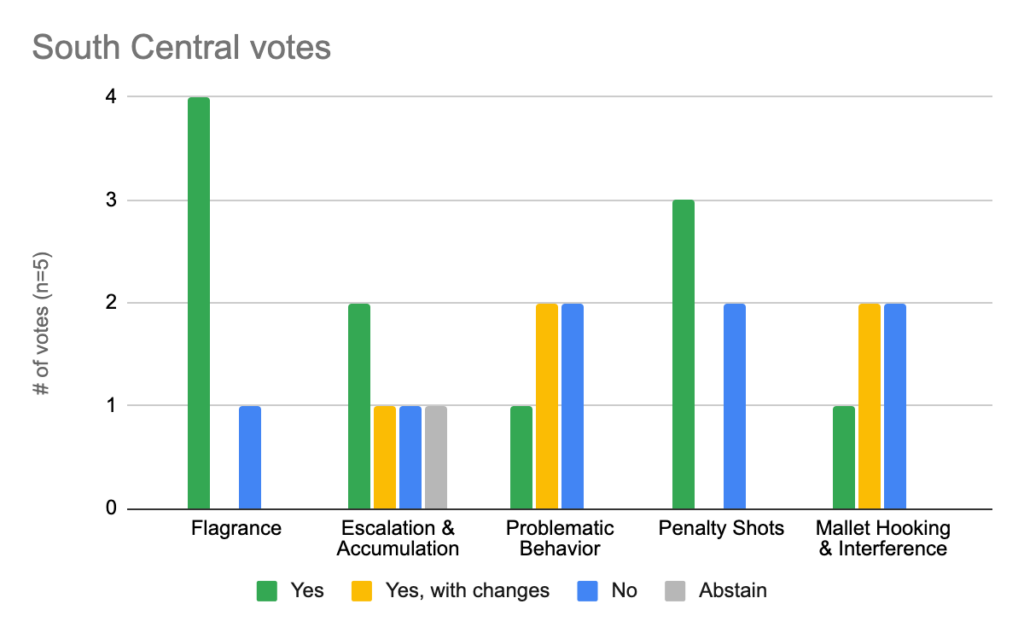
South East
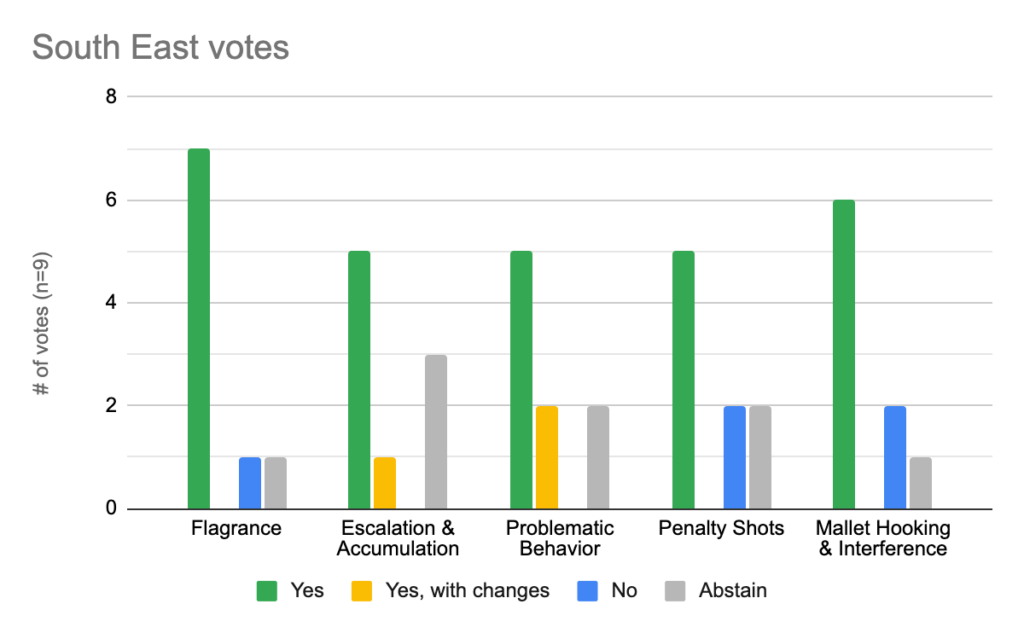
South West
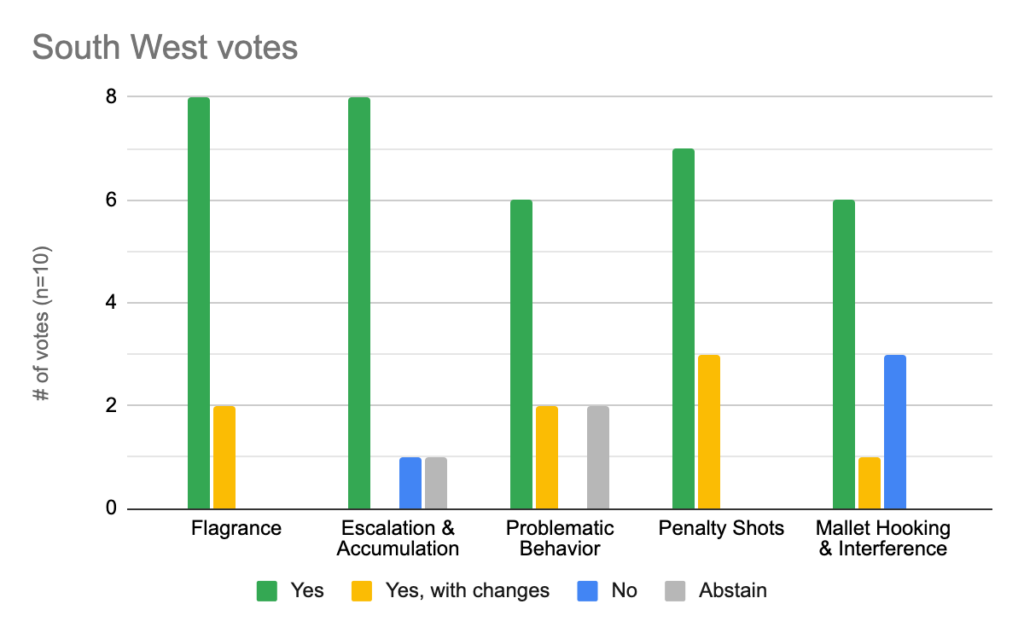
Next Steps
We have incorporated most of the changes mentioned above and published a first version of the 2022/23 ruleset here: https://nahbpa.gitbook.io/2022/ . Moving forward, we may take additional feedback to adjust wording, fix grammar or reference errors, etc., before it is finalized, but please use the updated version in qualifiers. The only rule left out was Problematic Behavior, as that is going to take more time to give it the consideration it deserves. Please email your Regional Representative or joe@nahardcourt.com with questions or concerns.
En Español
Primero que nada, queremos agradecer a todos los clúbes por comprometerse y participar en este proceso. Sabemos que el Reglamento es un documento técnico y que necesita análisis gramático, encima de que la mayoría de lxs jugadores lo utiliza en su totalidad únicamente una o dos veces al año en torneos. La continua evolución del juego se logra primariamente dentro de los clúbes y en todos los increíbles torneos que son organizados a través del año, pero tenemos que intentar codificar estándares para que a el nivel competitivo sea seguro, justo y emocionante.
Antes de que nos adentremos en los detalles de los resultados de la votación, queremos compartir muchas de las conversaciones importantes que han surgido durante este proceso. El futuro del manejo del Arbitraje y el Reglamento es un tema de constante discusión. Es por esto, que aquí presentamos una pequeña lista de proyectos y procesos de cambios que podrán verse en los siguientes años:
- Reglas
-
- La NAH desarrollará un mecanismo nuevo que asegure un sistema más democrático para las propuestas de cambios al Reglamento en el futuro, así como para las aclaraciones del mismo. Existe la percepción de que el Reglamento es el producto de la opinión de una persona o un grupo pequeño de personas, y estamos comprometidos a cambiar esa opinión.
- La NAH desarrollará un “Manual para Jugadores” con el propósito de que aquellxs jugadorxs nuevxs o no que no estén interesadxs en el arbitraje entiendan los nuevos estándares establecidos en el ahora actual Reglamento. El manual será corto y simple. Esto es hecho comúnmente en ligas de otros deportes. El actual Reglamento tiene la intención de ser un documento técnico que los árbitros y los organizadores de torneos deben comprender en su totalidad. Tener un Manual para Jugadorxs escrito en un lenguaje más sencillo, con ejemplos y videos, ayudaría de manera importante a hacer las reglas más accesibles.
- Arbitraje
- La NAH trabajará con otros grupos e individuos para dedicar recursos a entrenar más árbitrxs e incrementar en general la fluidez del Reglamento dentro de la comunidad. Lxs Jugadorxs pueden recordar que en 2013/2014 desarrollamos un examen de certificación para árbitros que incluía videos, pero era necesario una calificación manual y era mucho menos interactivo de lo que sería cualquier entrenamiento en persona. Adicionalmente, los gastos generales requeridos para mantener, actualizar y procesar esos examenes no eran sustentables debido a que sólo un par de personas estaban interesadxs en los examenes. Dicho lo anterior, nos damos cuenta de que algo diferente necesita hacerse y creemos que eventos que se enfoque en el arbitraje serán más atractivos y un mejor uso de los recursos.
Si te gustaría involucrarte en cualquiera de estos esfuerzos, siempre serás bienvenidx a unirte a nuestro equipo.
Resultados de la Votación
Visión general de los resultados y cómo leerlos:
- Primero, si un club no votó o respondió el formulario, NO les incuímos en la totalidad de los votos. Los únicos votos que contaron fueron aquellos en los que un Representante de clúb respondió el formulario de votación.
- Las gráficas de abajo, representan los votos emitidos por los Representantes de clúb. También analizamos todos los votos de “Sí, con cambios” y explicamos cómo planeamos incorporar dichos cambios al Reglamento.
- Hemos hecho un resumen de la retroalimentación que recibimos, de forma que no atribuimos cosas en específico a ningún clúb en particular.
- Al final de la discusión de cada cambio sugerido, incluímos la “Cuenta de votos final” en negritas y resaltada. Los cambios sugeridos en los votos de “Sí, con cambios” que pudimos incorporar al Reglamento equivalen a un voto como “Sí” y los cambios que no pudimos incorporar de aquellos votos como “Sí con cambios” equivalen a un “No”. Ajustamos los votos al final, para que sea posible ver como quedo la cuenta después de incorporar cambios cuando fue posible.
Flagrancia
El cambio a la regla de la flagrancia ha sido aprobada.
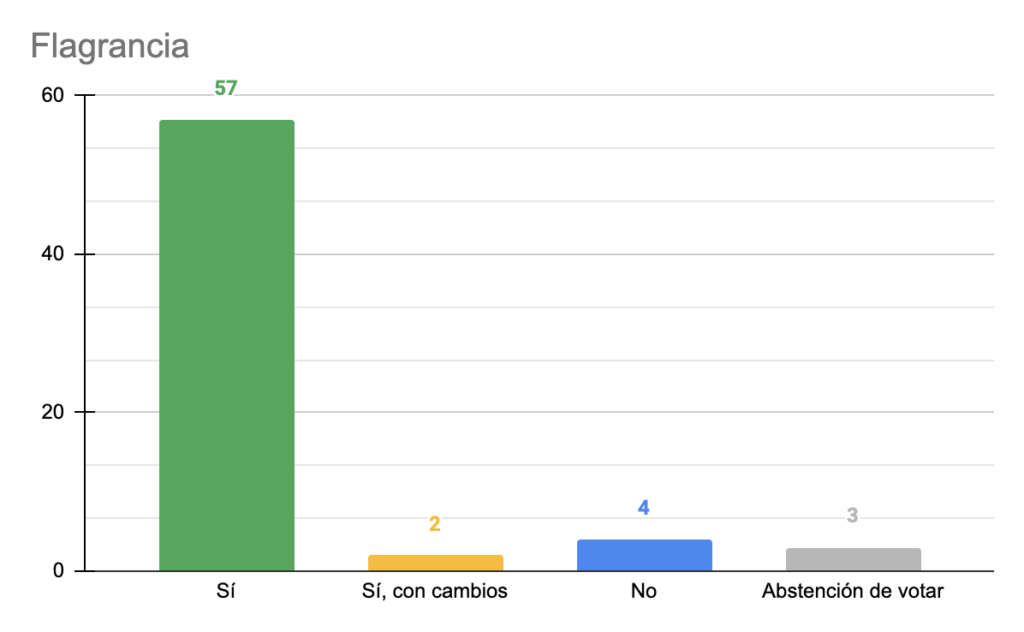
Esperamos que el cambio asegure que todxs lxs jugadorxs dentro de la cancha mantengan el estándar de ejecutar contacto físico de forma segura y estratégica. No hubo cambios propuestos que pudiéramos implementar, así que todos los votos de “Sí con cambios” han sido contados como “No”. La totalidad de los votos es: 57 Sí, 6 No, 3 Abstenciones.
Escalación y Acumulación
La actualización a la regla de Escalación y Acumulación ha sido aprobada.
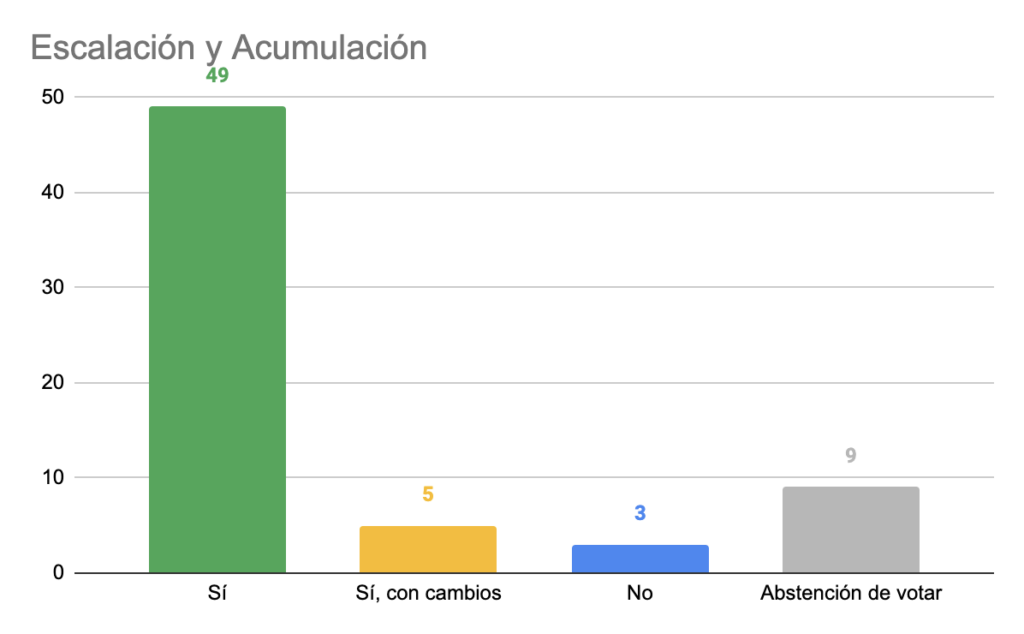
Hubo dos cambios sugeridos que pudiéramos implementar:
- Deberíamos eliminar el requisito de dabbing para escalar a un menor.
- Deberíamos crear una plantilla para usar en torneos para rastrear las faltas de lxs jugadorxs.
Nuestra respuesta a la primera sugerencia es que 6.1.2.1 establece que le Árbitrx no tiene que evaluar una pérdida de balón. Le Arbitrx puede evaluar un Menor o Mayor independientemente de si le jugador hizo dabbing, basado en una serie de factores a discreción de Árbitrx. Si elimináramos el lenguaje de 6.1.2.1 o 6.1.2.2, eliminaríamos las pérdidas de balón del juego por completo, lo cual apoyamos por completo. Sin embargo, podría cambiar la forma en que votaron otros clubes. No incorporaremos ese cambio. Esta sugerencia no pareció suficiente para cambiar el voto de ‘Sí’ a ‘No’.
Conducta Problemática
La actualización a la regla de Conducta Problemática ha sido aprobada.
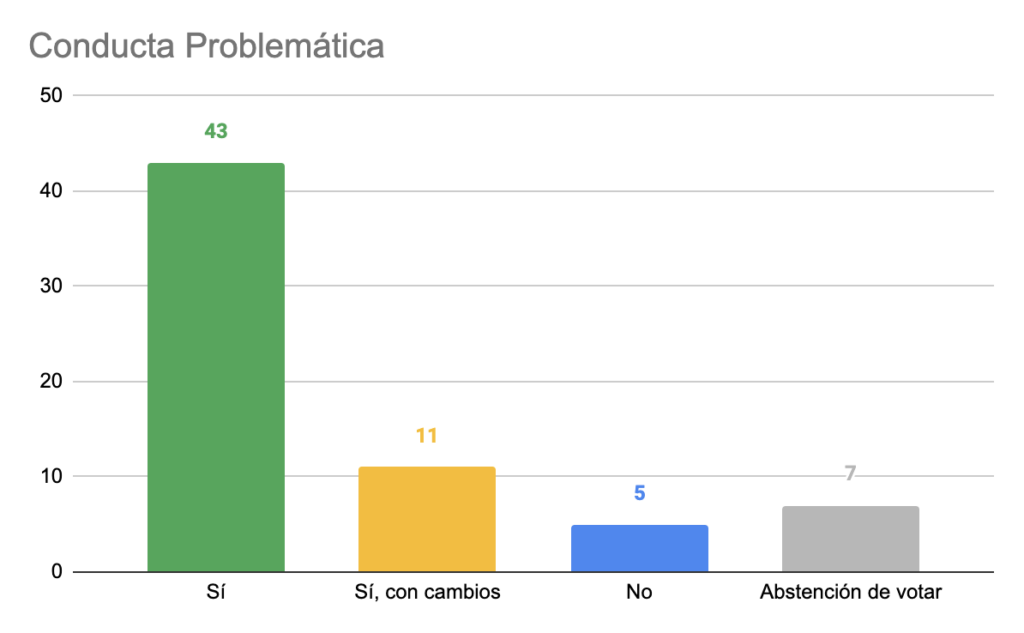
Hubo muchas sugerencias e inquietudes con respecto a esta regla. Aquí hay algunos puntos parafraseados que se hicieron y algunas sugerencias prácticas:
- Solo deben ser los organizadores del torneo quienes determinen si un jugador es elegible, no los capitanes de los equipos.
- Esta regla solo debe invocarse ANTES del torneo, con una cantidad de tiempo razonable para que ese equipo encuentre un reemplazo y para evitar que alguien reserve un viaje a un torneo en el que no es elegible para jugar.
- El jugador expresando preocupaciones no debería tener que revelar ninguna información personal durante este proceso.
- El jugador problemático debería tener la oportunidad de defenderse.
- Debería haber una conversación continua sobre esta regla y cómo mejorarla.
- NAH debe proporcionar un formulario estándar para completar, para garantizar que este proceso no genere más problemas.
- Hay preocupaciones generales sobre las personas que usan esta regla como arma por razones maliciosas o insignificantes.
Todos estos son excelentes comentarios y aportes. NAH trabajará para proporcionar un proceso más formal (junto con la producción del Código de Conducta en cuestión) que incluirá una plantilla que estandarizará el proceso y ayudará a proteger a las personas que invocan la regla de cualquier daño adicional. Por la forma en que está escrita la regla, no se esperaba que el jugador que invoca la regla tuviera que revelar más información personal de la necesaria, e incluso puede hacer que otra persona expresa preocupación en su nombre para permanecer anónimo.
Con respecto a que los organizadores del torneo o NAH tengan la responsabilidad exclusiva de determinar la elegibilidad de los jugadores, diríamos que es un paso atrás. Con frecuencia hay una mayoría de jugadores que compiten en el torneo que se sienten incómodos con alguien que está allí, pero los organizadores no pueden empatizar y, por lo tanto, no actuarán en consecuencia. Este proceso no pretende ser una “juicio de compañerxs”, sino más bien una plataforma para que todos en el torneo tengan la misma voz donde es posible que no hayan tenido ninguna voz en el pasado. Creemos firmemente que la NAH no puede actuar como un tribunal y que los organizadores de torneos son un grupo demasiado pequeño para soportar esta carga. No haremos ese cambio a la regla en este momento, sin embargo, esto es lo que haremos: NAH ayudará a formar un grupo de trabajo para desarrollar esta regla con voces adicionales en la conversación. Fue un esfuerzo de grupo para este primer borrador, y escuchamos alto y claro que tal vez se justifica una segunda mirada. Eso es justo, y trabajaremos para que esto suceda antes de las eliminatorias si es posible, pero puede llevar tiempo para encontrar puntos en común.
Se publicará una versión actualizada de la regla propuesta en la versión final, pero estamos comprometidos a volver a evaluarla cuando el grupo de trabajo se sienta listo para hacer cambios.
De los votos de “Sí, con cambios”, hubo 5 que eran accionables y 6 que no eran accionables en este momento o iban más allá del alcance de lo que se puede hacer dentro del conjunto de reglas específicamente. El conteo final de votos ajustado después de incorporar cambios o “rechazar” cambios es 48 Sí, 11 No, 7 Abstenciones.
Tiros de Penal
La actualización a la regla de Tiros de Penal ha sido aprobada.
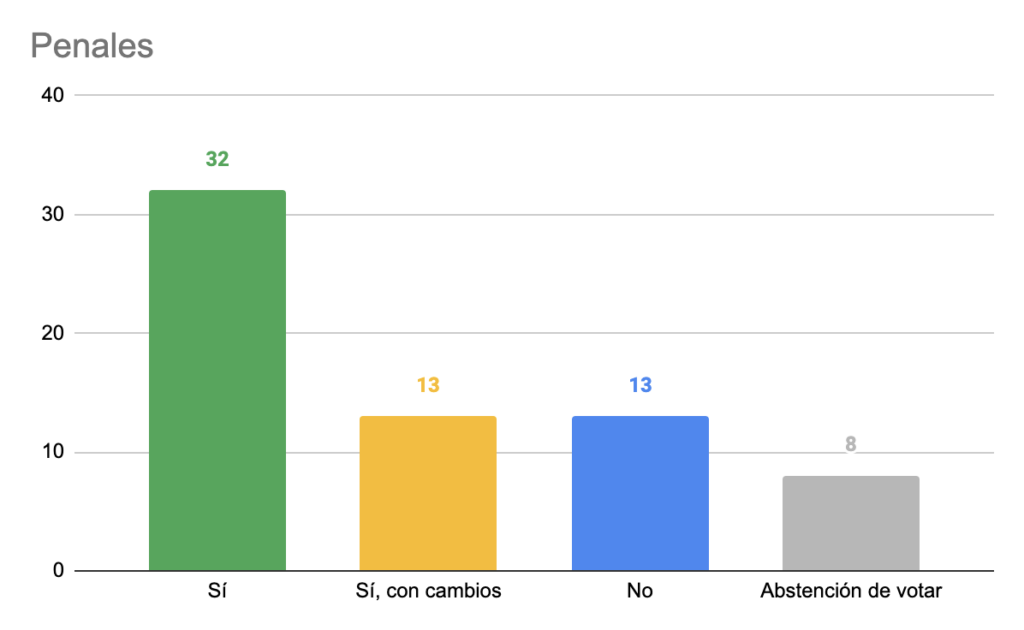
Hubo algunas sugerencias/preguntas consistentes:
- Eliminar la posibilidad de que el tirador tenga un segundo tiro de un rebote.
- El jugador que recibió la falta debe realizar el tiro, y el jugador que estaba en la portería se debe quedar en la portería.
- Quitar el tiro penal a portería vacía y simplemente aplicar el gol.
- El portero debe permanecer en el área de portería hasta que se ejecute el tiro penal.
Todas estas son sugerencias válidas y, debido al volumen de las mismas, las incorporaremos a la regla. Adicionalmente, la regla establece que el juego está muerto después de que se produce el tiro penal y describe exactamente cómo se reiniciará el juego. Hubo cierta confusión sobre si el juego comenzaría inmediatamente como si la pelota estuviera viva después del tiro penal, pero esto parecía demasiado impredecible en este momento. La versión actualizada de la regla propuesta se publicará en la versión final del conjunto de reglas.
De los votos de “Sí, con cambios”, todos eran procesables y su incorporación probablemente no cambiaría los otros votos de Sí. El conteo final de votos ajustado después de incorporar los cambios es 45 Sí, 13 No, 8 Abstenciones.
Enganches y Interferencia
La actualización a la regla de Enganches y Interferencia ha sido aprobada.
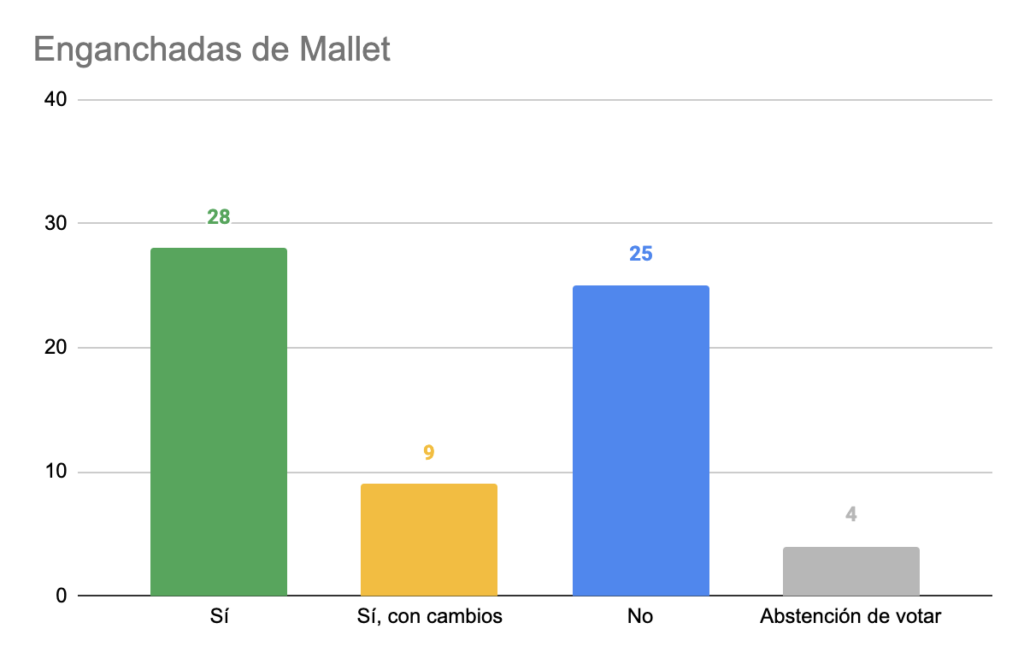
Este fue el voto más divisivo y recibimos muchos comentarios positivos. Haremos nuestro mejor esfuerzo para parafrasear los temas comunes que se compartieron:
- Se necesita más especificidad sobre cuándo y dónde un jugador puede tocar un mazo.
- El enganche debe permitirse en ciertos escenarios pero no en otros.
- Esta regla se siente como un estilo impuesto y podría resultar en un arbitraje parcial.
- La regla debe centrarse en el juego inseguro con el bastón/mallet y no en el juego táctico con el bastón/mallet .
La mayoría de los comentarios provinieron de votos de ‘No’, pero centraremos nuestras respuestas en los comentarios que vinieron de votos de ‘Sí, con cambios’:
Creemos que permitir el enganche en algunas situaciones pero no en otras solo agregará más confusión a esta regla y que una prohibición total de enganche es mucho más fácil de comunicar y hacer cumplir. El enganche incidental ocurrirá de la misma manera que ocurre el contacto incidental con la bicicleta, y eso está bien. El trabajo ahora es enfocarse en aplicar la regla y hacer que los Árbitrxs estén en la misma página sobre cómo hacerla cumplir.
Reconocemos que en la primera implementación de una regla como esta, la especificidad ayuda significativamente con la curva de aprendizaje. Al igual que con la Interferencia/Obstrucción, había confusión sobre dónde los jugadores podían montar o no montar, estar o no estar. Esto está bien. NAH actualizará la regla para agregar más claridad antes de implementarla y trabajará con los clubes que expresaron esta preocupación para que el lenguaje final sea satisfactorio.
De la misma manera que Europa se sintió atacada inicialmente por la regla de interferencia y la regla de rayos de portería, podemos entender por qué esto puede parecer una condena de cierto estilo de juego. Conceptualmente, nunca consideramos que jugar con bastones fuera parte de un estilo específico, y parece que los clubes de todas las geografías votaron ‘Sí’ y ‘No’, lo que demuestra claramente que la narrativa regional puede ser demasiado reduccionista. Sin embargo, queríamos resaltar la preocupación de que puede haber Árbitrxs que tengan un cierto punto de vista y puedan castigar a ciertos jugadores. Si bien, este es un argumento bastante no específico para esta regla, en realidad podría aplicarse a cualquier regla, sigue siendo una preocupación completamente válida y, con suerte, a través de la educación, la conversación y la colaboración podemos evitar que eso suceda. Cada árbitrx tiene diferentes límites para sus acciones y esperar que sean mecánicos o robóticos no es posible en ningún nivel deportivo. Lo que es una infracción de manubrio para un Árbitrx puede ser un contacto incidental con la bicicleta para otro Árbitrx. Esta es la realidad del arbitraje. Todo lo que podemos hacer es brindarles a todos una plataforma para expresar sus preocupaciones y participar en futuros esfuerzos de entrenamiento de árbitrxs, y alentar la conversación dentro de la comunidad.
Creemos que no se puede separar la seguridad con el baston del juego táctico con el baston, porque muchas veces son las maniobras tácticas las que dan lugar a situaciones peligrosas. Además, queremos explicar el razonamiento competitivo detrás de la propuesta de regla: la premisa es que restringir a un jugador con algo que no sea su posición en la cancha es antitético al espíritu del juego. En nuestras discusiones y revisiones de la regla, quedó más claro que un juego con la pelota que implica restringir el equipaje de tus oponentes ciertamente crea situaciones inseguras y podría decirse que se opone al movimiento libre y abierto en la cancha. Algunos argumentaron que la estrategia, la habilidad y la ejecución son los tres componentes centrales del juego, y restringir el baston, los brazos, agarrando de las camisetas, etc. de un jugador, neutraliza esas tres cualidades. Esta propuesta de regla fue un referéndum sobre esa premisa y los resultados muestran que muchas personas que juegan en todos los niveles están de acuerdo.
Puede estar de acuerdo o en desacuerdo con los puntos mencionados anteriormente y claramente la comunidad está razonablemente dividida. Debido a esa realidad, NAH se compromete a votar sobre esta regla nuevamente la próxima temporada. Los jugadores tendrán tiempo para probarlo, encontrar los límites de la regla, darnos su opinión y tal vez adaptarse de la misma manera que lo hicieron con Interferencia/Obstrucción. Considere esta una temporada piloto para esta regla y, con suerte, el próximo año podremos hacer que los jugadores voten sobre esto para tener una mejor idea de cómo se siente la gente sobre jugar el juego de esta manera en un entorno competitivo.
De los votos de ‘Sí, con cambios’, sentimos que 7 de ellos podrían abordarse y 2 de ellos no. El conteo final de votos ajustado después de incorporar cambios o “rechazar” cambios es 35 Sí, 27 No, 4 Abstenciones.
La versión actualizada de la regla propuesta se publicará en la versión final del conjunto de reglas.
Club Voting Records
Cascadia
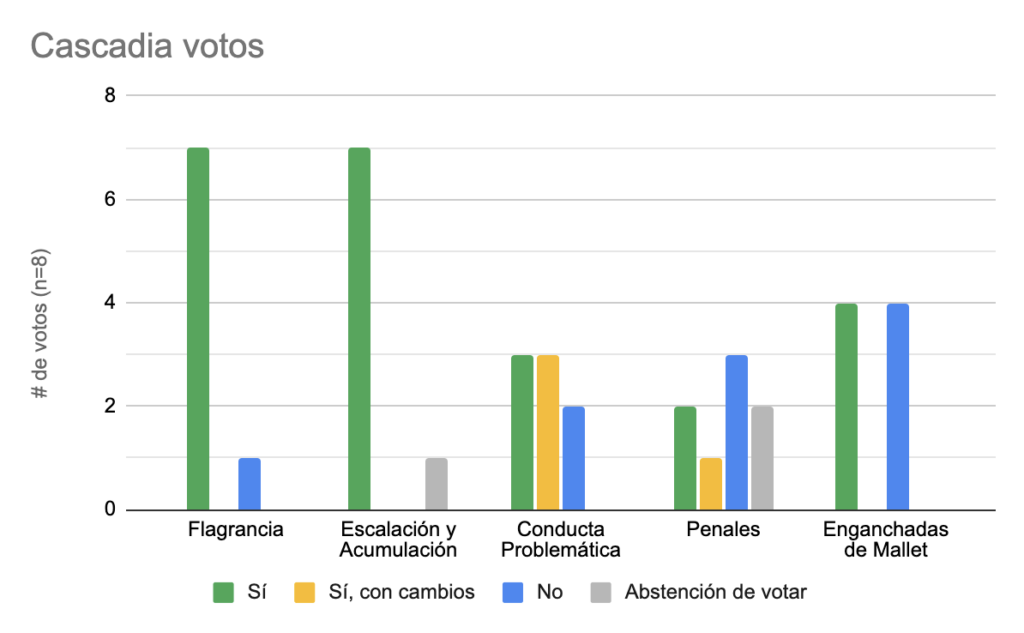
Eastside
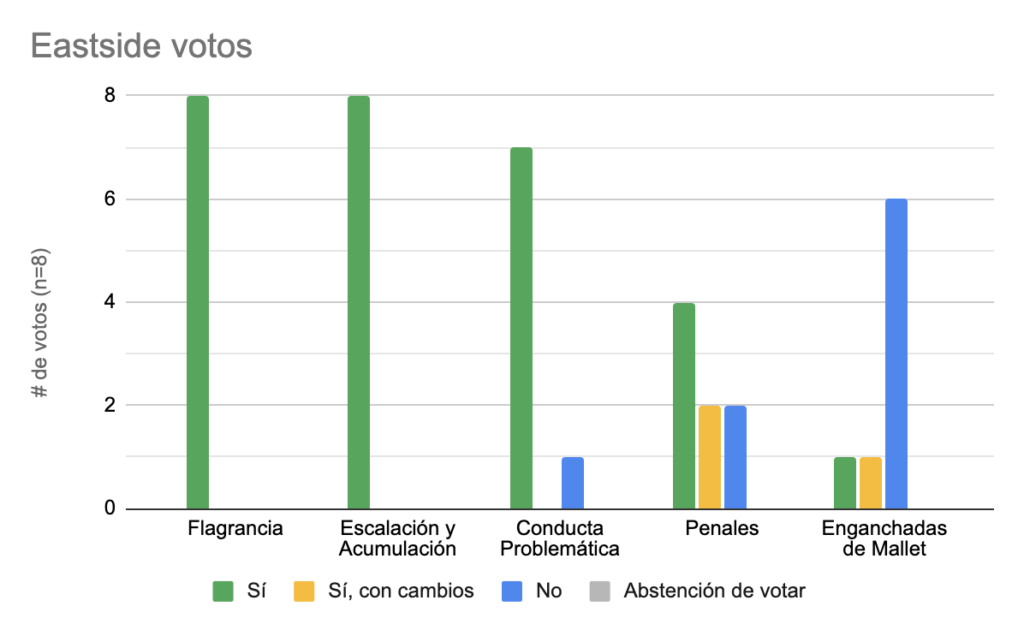
Great Lakes
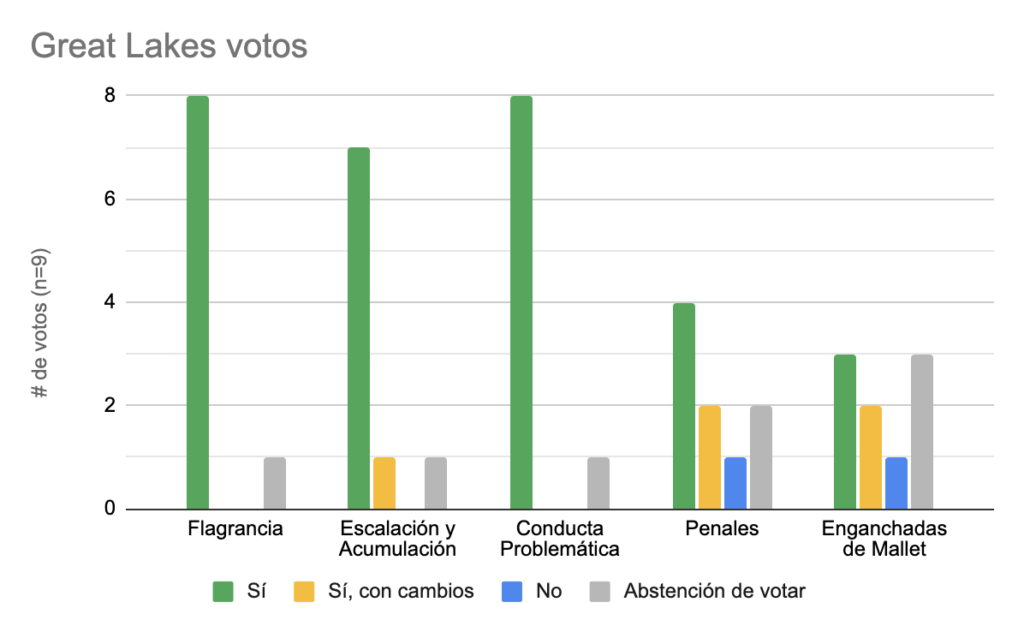
Great Plains
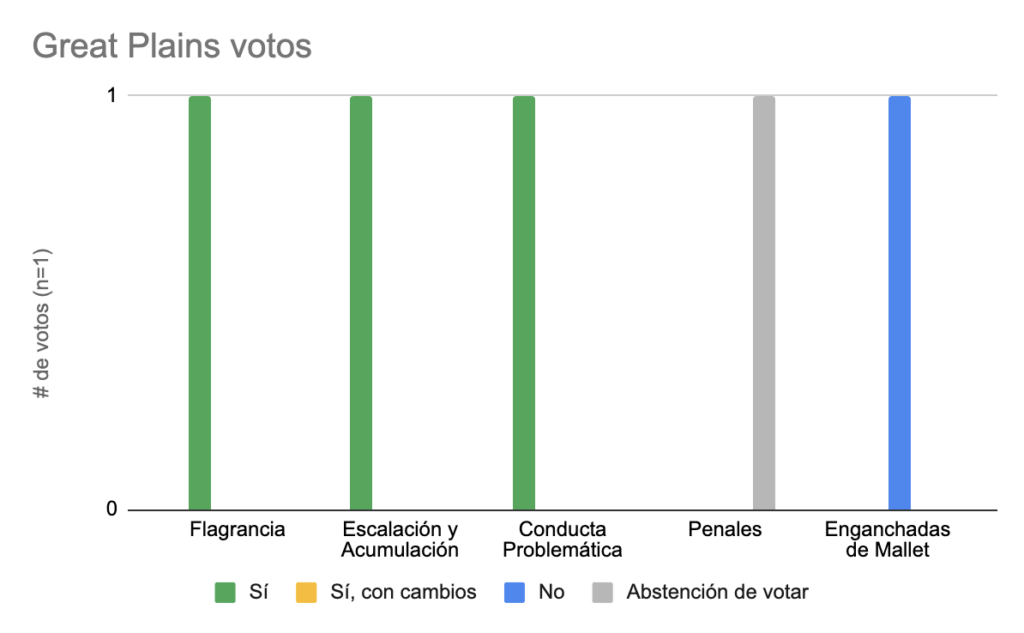
Heartland
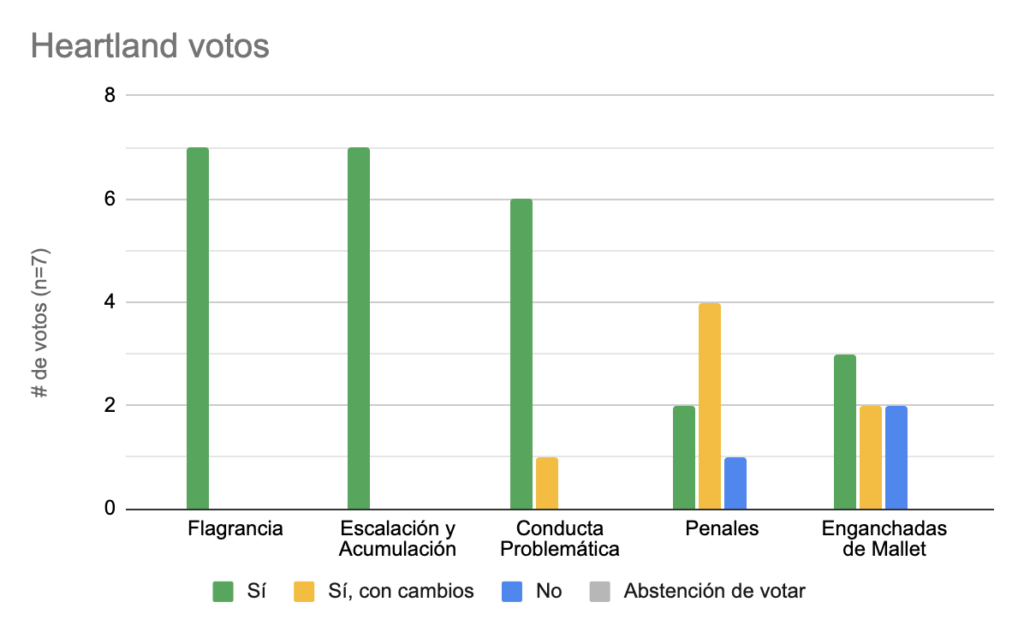
Mexico
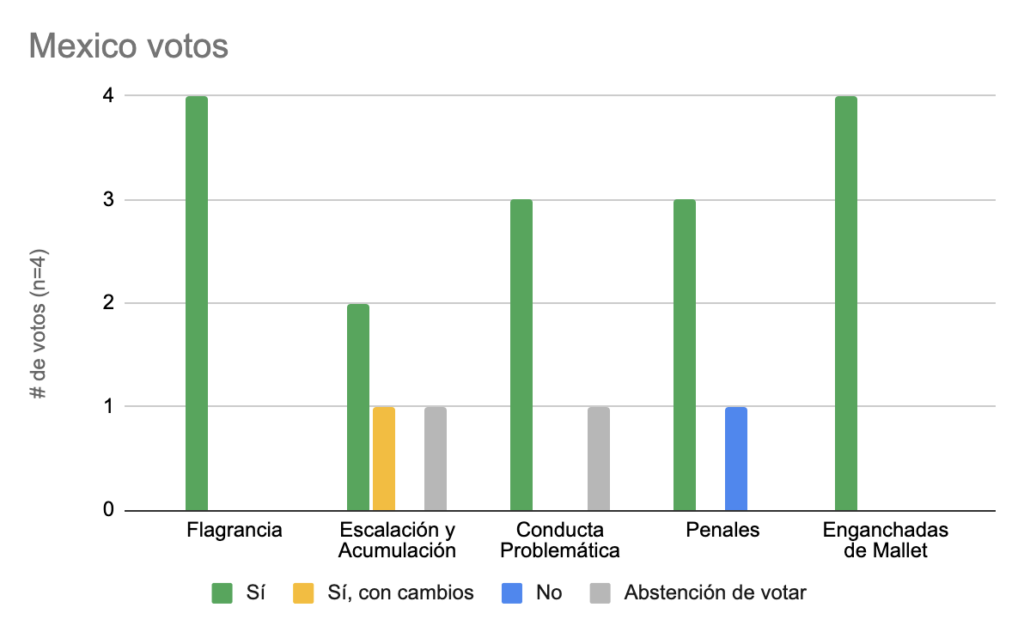
Northside
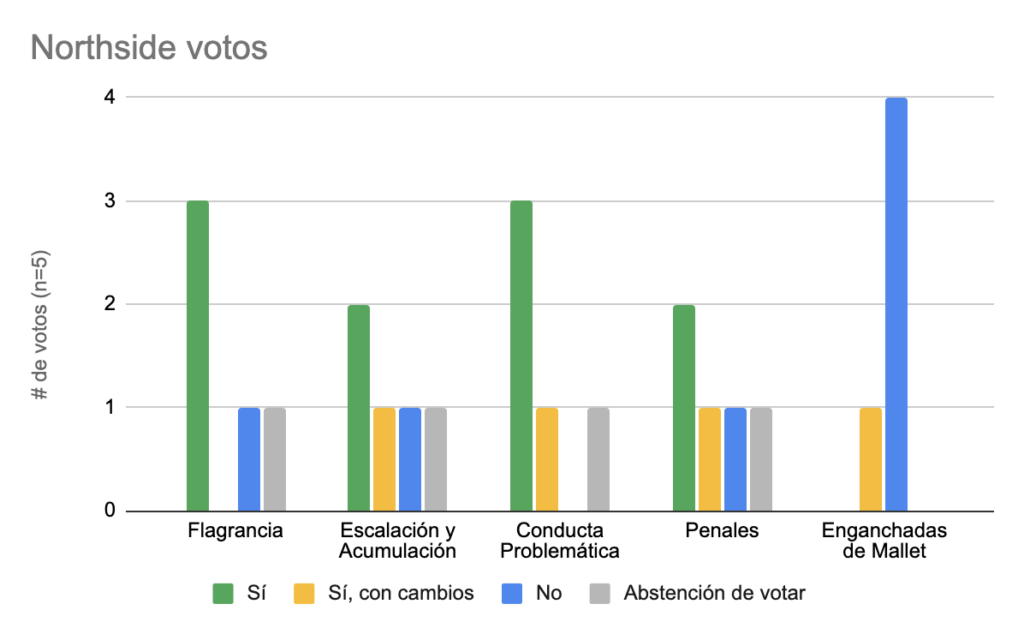
South Central
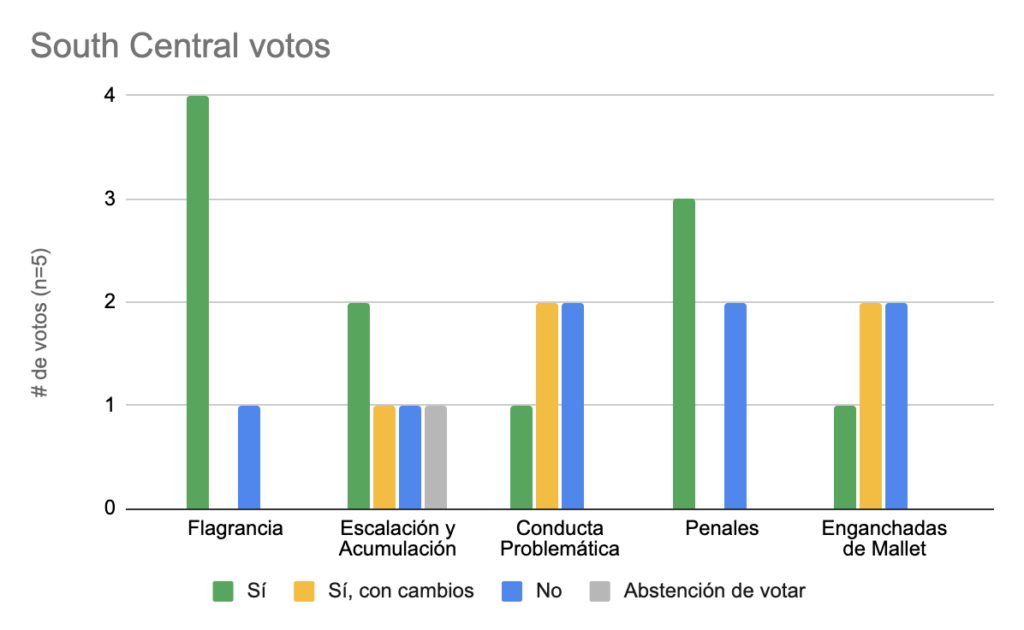
South East
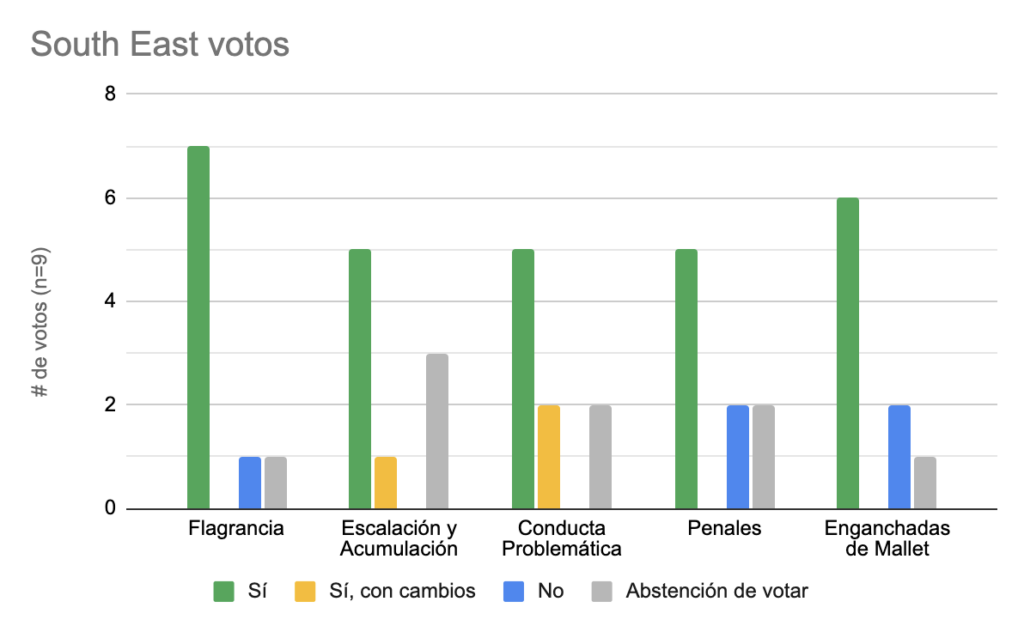
South West
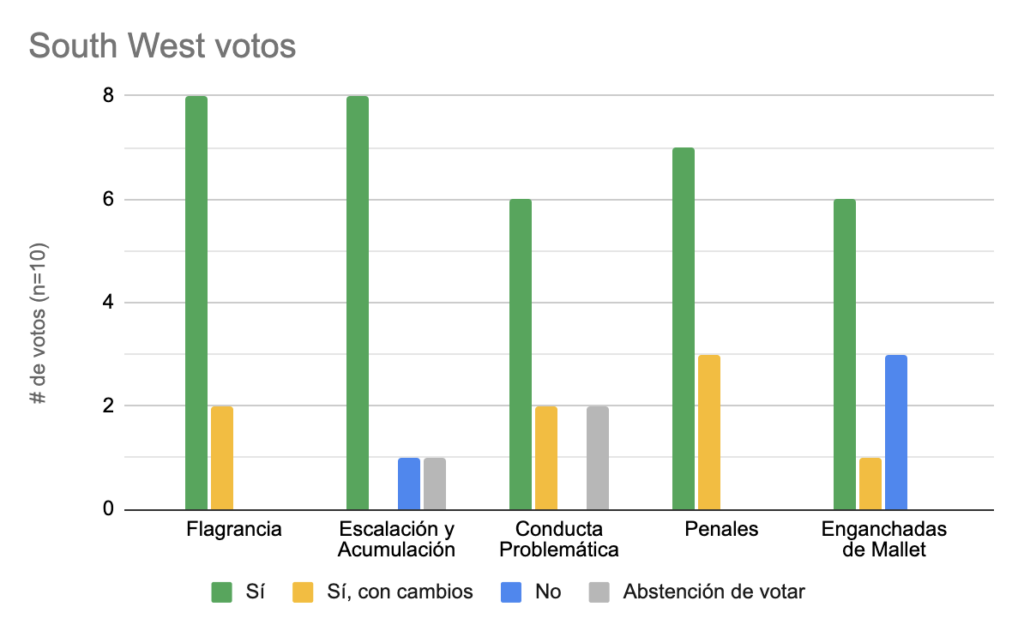
Próximos Pasos
Hemos incorporado la mayoría de los cambios mencionados anteriormente y publicamos una primera versión del conjunto de reglas 2022/23 aquí: https://nahbpa.gitbook.io/2022/. En el futuro, es posible que recibamos comentarios adicionales para ajustar la redacción, corregir la gramática o los errores de referencia, etc., antes de que finalice, pero use la versión actualizada en los calificadores. La única regla que quedó fuera fue la Conducta Problemática, ya que llevará más tiempo darle la consideración que se merece. Envíe un correo electrónico a su representante regional oa joe@nahardcourt.com si tiene preguntas o inquietudes.